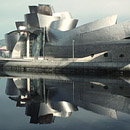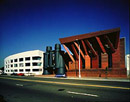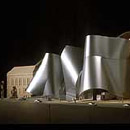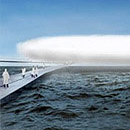 |


![]()
> archived articles
> write for core! be famous!
|
Frank Gehry's Attack of the Clones By Amos Klausner A recent interview with architect Frank Gehry about new visions for Ground Zero (published in the New York Times Magazine) has lifted the veil that had eloquently shielded us from a new paradigm in the relationship between architecture and culture. In Deborah Solomon's interview she asks the revered master of form and space if he considered a proposal for the site. He replied, honestly, that he was invited to participate but found it demeaning that they could only offer $40,000 in return for his creativity and architectural plans. He said, "When you're only paid $40,000, you're treated as if that is your worth." Could Gehry have such a severe case of low self-esteem that he can only measure his talent by the size of architectural fees and construction budgets? The veil that Frank Gehry lifted, if just for one interview, opens our eyes to a recent shift in the role buildings play in an increasingly shared cultural experience. Size does matter. Not size quantified by building envelopes and square footage and but as global purveyor of image, identity and brand. | |
 Guggenheim Bilbao  Chiat-Day  Corcoran |
Today Frank Gehry has the power to forge a forgotten city, wake a tired institution or cleanse a moldy corporate identity. The right building can bring recognition for museums with lackluster collections, can increase tourism and bring needed revenue into a slumping economy. And it was Gehry's Guggenheim in Bilbao that was the catalyst for this shift. Since then, the architect has created a perceived corporate brand (the value of which we must assume is greater than $40,000) and he has franchised a host of Gehry-isms that are beginning to populate sites including Los Angeles, Biloxi, Chicago, Washington D.C., Toronto, and Jerusalem. Get ready for billowing waves of titanium skin blowing across the continents. Michael Sorkin, Director of the Graduate Program in Urban Design at the City College of New York wrote in an article entitled, Brand Aid published in the Harvard Design Magazine that "The advocacy of branding is a sell-out in architecture, reducing its meanings to mere advertising, a fine obliviousness to the larger social implications of architectural practice." Gehry's refusal to offer a proposal for Ground Zero, based on his awkward sense of value, firmly places the architect in this oblivion. The real danger to architecture's inherent responsibility to support wider social goals like affordable housing lies in the beauty of Gehry's buildings. Everyone wants one. They want Bilbao along with the positive civic effects that elevated the depressed Catalan region of Spain. As the franchise keeps expanding the buildings take on the role of status symbol, losing the cultural value that community leaders want. Will people still flock to Bilbao or make that side trip to Biloxi, Mississippi if they have their own look-alike Gehry? Architect Rem Koolhaas, no stranger to building brand identity, writes in the introduction to Projects for Prada Part 1, "Indefinite expansion represents a crisis: in the typical case it spells the end of the brand as a creative enterprise and the beginning of the brand as a purely financial enterprise." He continues, "The danger of the large number is repetition: each additional store reduces aura and contributes to a sense of familiarity." That's the trouble with franchises. Even the ubiquitous restaurateur MacDonald's, which recently posted their first quarterly loss, announced that they would close unprofitable operations. They are losing market share to upstarts like California's In-N-Out Burger, a restaurant that prides itself on "hand-leafed" lettuce (where an employee manually pulls apart a head of iceberg lettuce as opposed to shredding it in a machine) and a single floor plan across all sites. It makes finding the bathroom a snap. Perhaps Gehry will include time saving ideas like this into his fleet of silver clad clones. |
|
The revised First Things First Manifesto asked communication designers to come to terms with the notion that their talent is being directed toward the advertising, marketing and promotion of consumer products and services, not toward charitable causes, education and social programs. The manifesto states, "Designers who devote their efforts primarily to advertising, marketing and brand development are supporting, and implicitly endorsing, a mental environment so saturated with commercial messages that it is changing the very way citizen-consumers speak, think, feel, respond and interact. To some extent we (designers) are all helping draft a reductive and immeasurably harmful code of public discourse." Gehry's attitude about money may not be indicative of his overall sense of social responsibility yet he continues to promote a product that is based on performance, replication and the bottom line. In doing so he has marketed his work as faux tourist attractions where consumers can whittle away a few hours of their vacation in pursuit of culturally approved activities. | |
 Leavittown |
Gehry, however, isn't the first to employ brand development as an architectural tool. Some might argue that Frank Lloyd Wright was an expert in creating a mystique about his work but it was in the early 1950's that two developers, William Levitt and Joseph Eichler, created housing developments that would have a powerful impact on the way American families inhabit space. They showed that architecture as brand can be a positive social force. In New York Levitt developed affordable single-family housing communities, clustering neighborhoods around "village centers". On the west coast Joseph Eichler re-interpreted California living in much the same way. He built inexpensive, modern starter homes incorporating his own ideas on community planning and shared green space. |
|
More recently Samuel Mockbee started the Rural Studio at Auburn University and began a new type of franchise, but again one that centered on architecture as champion of the underclass. Working with university architecture students, Mockbee designed and built a variety of houses and community buildings for the impoverished residents of Hale County, Alabama. Using recycled and low cost materials, the Rural Studio has been able to provide adequate structures for a community that has yet to visit Bilbao (and probably never will). Mockbee's own philosophy on building is inspiring in the face of Gehry's new corporate architecture. He said, "For me, these small (Rural Studio) projects have in them the architectural essence to enchant us, to inspire us, and ultimately, to elevate our profession. But more importantly, they remind us of what it means to have an American architecture without pretense. They remind us that we can be as awed by the simple as by the complex and that if we pay attention, this will offer us a glimpse into what is essential to the future of American Architecture: its honesty." | |
 Blur  Blur |
Gehry's perpetuation of a good idea is reminiscent of painter Roy Lichtenstein's success with the Benday dot screen the artist used to paint his first comic strip scenes. Lichtenstein's work was continuously popular until his death in 1997 yet he never moved completely away from the use of dots. While his is a cautionary tale for the likes of Frank Gehry there are designers who are already trying to bust through the big money archetype that has held sway for the past two decades. Elizabeth Diller and Rick Scofidio's recent Blur building constructed for the Swiss Expo 02 on Lake Neuchatel in Switzerland is a wonderful example of the anti-franchise. Built on top of the lake the Blur building, with over 30,000 nozzels spraying a fine mist of water, creates its own unique environment. The Blur building revels in its unpredictability. In the anthology Anything, Elizabeth Diller notes that Blur, "takes on the uncertainty of the future epitomized in the weather." In light of breakthrough ideas like these, Gehry's tilted army of polished soldiers seem all the more like parodies of themselves. Each one debases the next in much the same way that America's newest favorite family, The Osbournes, have been able to become caricatures of themselves in such a short period of time. When does a building merely become a tool to sell an idea, a product, or a company? The genesis of this may have started for Gehry in 1991 when he completed the Chiat/Day building in Venice, California. Working with artists Claes Oldenburg and Coosje van Bruggen, the architect branded the project with an oversized pair of architectural binoculars that reflected both the nature of Chiat/Day's daily business and its long-range outlook. The ad agency has since abandoned the building. Frank Gehry is busier than ever (regardless of what he says in the Deborah Solomon interview about not getting a lot of work) perpetuating his unique brand, keeping up with a growing franchise and meeting his consumers' current predilections. With all that on his plate we must assume that there isn't any time left for a more philanthropic approach to his craft. Sadly, Samuel Mockbee passed away last year, and although the Rural Studio lives on, there is one less proponent of honesty in American architecture. |
|
Amos Klausner is the director of the San Francisco chapter of the American Institute of Graphic Arts. |
|